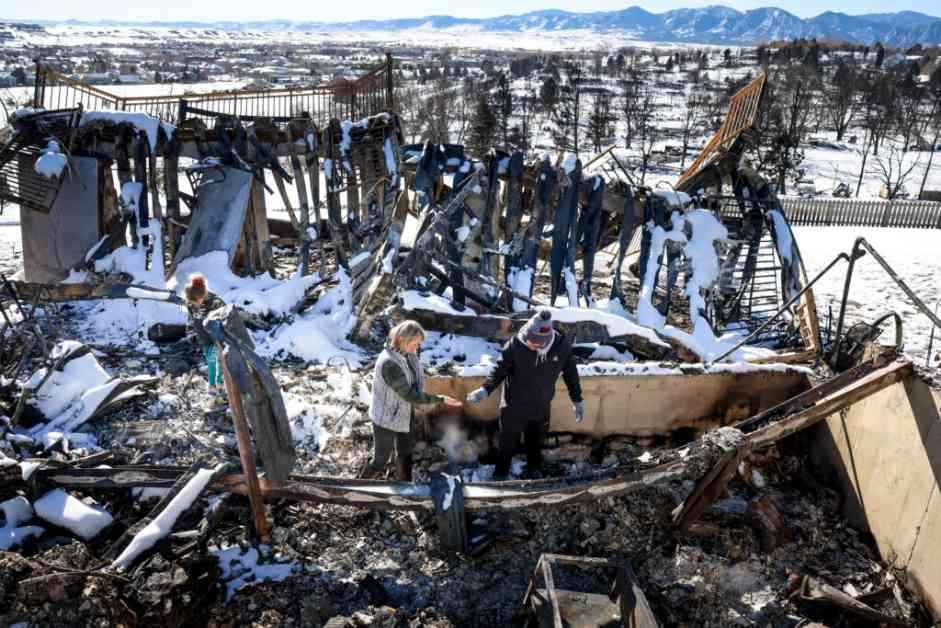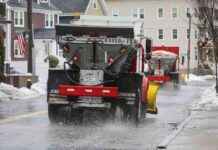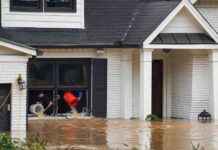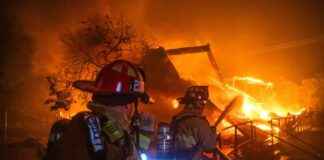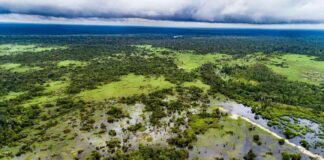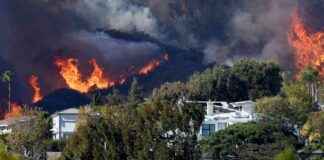The flames caught Erica Solove off guard, man. It was smack in the middle of winter in Colorado, where you expect blizzards, not fires. But on Dec. 30, 2021, the Marshall Fire ripped through Louisville and Superior in Boulder County, taking two lives and wiping out over a thousand homes. Erica’s crib was one of them. She bounced with her hubby, two little kiddos, and their yellow lab, only grabbing the clothes on their backs. Wallets, passports, birth certificates – all went up in smoke with the rest of the house. Her man was the only one rocking shoes, yo.
The next day, it started snowing. The fam hopped around hotels until they landed a rental in South Boulder. They chilled there until they could move back into their rebuilt spot in the summer of 2023. The construction project wrapped up quicker than expected, beating many estimates.
Then, in August, wildfires went wild on the Hawaiian island of Maui. Over 100 peeps got taken out, and 2,200 structures got wrecked, including pretty much the whole town of Lahaina. Erica was deep in her feels, seeing the devastation. She peeped the mistakes made in handling the emergency, the same ones she saw back in Colorado. She felt a pull to help out.
While the fires in Maui were still smoldering, Erica set up a Facebook group linking up Maui survivors with Marshall Fire survivors. She wanted to drop knowledge from her community’s post-fire lessons on dealing with insurance, mortgages, lost paperwork – “all the boring stuff we had to become experts in,” she said.
Not a lot of research is out there on how many climate activists have lived through a disaster themselves. But chatting with a dozen survivors of extreme weather showed how losing a home or a loved one can light a fire under peeps to become climate activists, so others don’t go through the same.
So, Erica’s story is becoming more common. With climate change cranking up the intensity and frequency of extreme weather events, more disaster survivors across the U.S. are teaming up to push for climate action and prep for future disasters.
In 2024, there were 108 major disaster and emergency declarations nationwide, messing with 137 million peeps – about 41 percent of the U.S. population, according to the International Institute for Environment and Development.
As the Trump admin weakens FEMA and holds back disaster aid from a bunch of states, survivors and advocates know it’s key to share their stories now more than ever.
Around 40 peeps joined Erica’s Maui survivors’ group. It was small, but it was her way of paying forward the love she got from strangers after losing her home. And guess what? It caught the eye of Extreme Weather Survivors, a new nonprofit rallying disaster survivors to help other victims and fight climate change.
Fast forward to now, Erica’s running Extreme Weather Survivors’ online crew of about 1,000 disaster survivors, insurance experts, health pros, and other peeps sharing resources and answering questions in real-time on Slack. The platform launched in January to coordinate relief efforts after the L.A. wildfires.
“Heartbreaking Pioneers”
Survivors have been organizing after fires and storms forever, pushing politicians to listen to their needs, only to feel ignored or left hanging.
In Western North Carolina, roads are still washed out and bridges are busted seven months after Hurricane Helene. Some survivors and online conspiracy theorists believe FEMA dropped the ball after the storm.
Some Louisville residents who lost homes in the Marshall Fire weren’t feeling new City Council rules that said new homes had to be built with net-zero carbon emissions. They thought it would jack up costs when most peeps just wanted to rebuild quick.
Insurance payouts and other help for survivors can take months or years to come through, causing more pain than needed.
Extreme Weather Survivors is the first group bringing together victims of what they call “unnatural disasters” to fight climate change.
Chris Kocher, one of the founders, got the idea after Hurricane Ida hit New York City in 2021, killing 14 peeps. He realized he could use his experience to create a group that supports survivors and pushes for stronger policies.
The organization kicked off in 2024, giving free resources in English and Spanish, like access to mental health pros and connections with other survivors for support.
“They are, in many ways, heartbreakingly, pioneers,” Kocher said of the group. “They’re among the first to get how real climate change is, how it’s hitting folks, and how it’s only gonna get worse.”
Extreme Weather Survivors is backing Vermont’s Climate Superfund Act, which makes fossil fuel companies pay for climate change damage in the state. The law, passed in May 2024 and now in federal court, would fund climate adaptation projects.
Less than two months after the law passed, another big flood hit Vermont, a year after the 2023 deluge. Two peeps died, and survivors who just rebuilt had to start from scratch again.
The group is also supporting California’s Senate Bill 222, which could let insurers get back climate-related losses from fossil fuel companies.
“A Sad Credibility”
Extreme Weather Survivors is all about telling stories.
“Humans vibe with stories,” Kocher said. “It’s easier to get one person’s story than to understand ‘Climate change is about to mess up everything.'”
Members are all over the country, spinning their tales, writing op-eds, and speaking at events. Last fall, a panel at NYC’s climate week with four survivors got the group a bunch of media shine.
Steve Koller, a Harvard postdoc, says sharing stories works ’cause peeps who don’t follow climate news might see themselves in a story of loss.
Koller got into studying floods, disaster programs, and decarbonization after surviving Hurricane Sandy in 2012. The storm changed his whole outlook and career path.
Nabila Wilson’s ‘climate light bulb’ moment came after her Houston ‘hood flooded three years in a row, capped by Hurricane Harvey in 2017. She saw how many peers didn’t see climate change as a real threat, and she decided to take action.
Wilson, now leading two environmental groups at Furman University, wants to empower her fellow youth to make a change in their communities.
Alicia Cooperman, a political scientist, says speaking up at local meetings and getting involved in local politics is key for survivors to make a difference. City policies can spread and improve across regions, she says.
But while most adaptation happens locally, a lot of the cash comes from the feds. The Trump admin axed billions in grants for climate-resilient projects, cut thousands of enviro jobs, and wants to nix funds for peeps hit hardest by climate change.
Earlier this week, the admin ditched all the scientists working on the National Climate Assessment, the big report on how climate change is messing with the U.S.
“They Have Been Failing Us Again and Again”
Finn Does was just 15 when he saw the North Complex Fire raging near his Cali home in 2020. The sky turned orange from the smoke, and he knew then that politicians couldn’t be trusted to solve the climate crisis.
Does joined a climate action group at his school, and by 2023, he was co-chair of the Bay Area Youth Climate Summit. Now 19 and studying at UC Berkeley, he’s deep into environmental law and policy, working with climate groups on and off campus.
Annie Barbour found her calling after the Tubbs Fire in 2017 wrecked her Santa Rosa home. She dove into volunteering and formed a group to help her neighbors rebuild and hold officials accountable.
After the Camp Fire hit Paradise, California, Barbour and her crew went to help survivors and officials, showing them there’s a way forward after a disaster.
Barbour now works at United Policyholders, guiding disaster survivors through their insurance claims. She’s seen peeps break down at the table, relieved to have someone who gets what they’re going through.
She’s traveled to Colorado, Maui, and L.A., lending support and sharing her experience.
An Invisible Killer
Fires and storms get all the attention for being wild and destructive. But extreme heat is a sneaky threat.
In 2024, Phoenix baked in 113 days with temps over 100 degrees. Over 600 peeps died from heat in Maricopa County, with even more in 2023.
Heat doesn’t leave a trail of destruction like a fire or a storm. It just empties the streets as folks try to stay cool. Homeless and outdoor workers are hit hardest.
The Stafford Act, the big law for federal disaster response, doesn’t call extreme heat a “major disaster.”
Amy Dishion got into Extreme Weather Survivors after her hubby died from heatstroke in 2022. She was already into climate activism, but his death gave her a new fire to push for change.
She hopes her story shows that behind the stats are real people getting hurt by climate change.
Dishion moved back to Salem, Oregon, after her man passed. When she shares her story, she’s thinking of her daughter’s future.
“I hope policymakers get it,” she said. “I want them to feel the pain I’ve felt from climate change and make a change.”
This story is funded by readers like you. Our nonprofit newsroom gives you top-notch climate coverage for free, no ads. We rely on donations to keep the news coming. Please donate now to support our work. Every little bit helps. Thank you for being part of our community!

